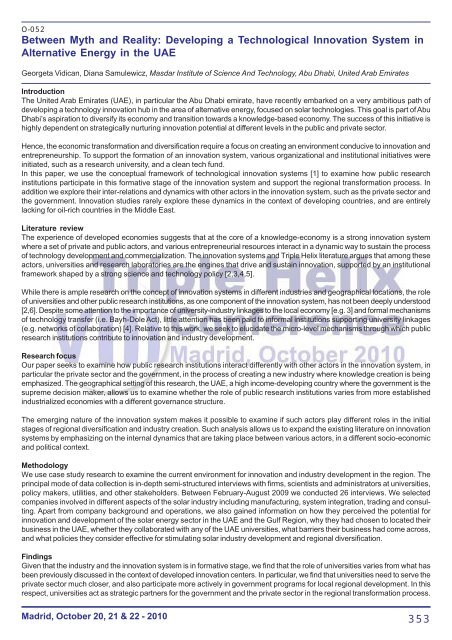TRIPLE HELIX noms.pmd
TRIPLE HELIX noms.pmd
TRIPLE HELIX noms.pmd
You also want an ePaper? Increase the reach of your titles
YUMPU automatically turns print PDFs into web optimized ePapers that Google loves.
O-052Between Myth and Reality: Developing a Technological Innovation System inAlternative Energy in the UAEGeorgeta Vidican, Diana Samulewicz, Masdar Institute of Science And Technology, Abu Dhabi, United Arab EmiratesIntroductionThe United Arab Emirates (UAE), in particular the Abu Dhabi emirate, have recently embarked on a very ambitious path ofdeveloping a technology innovation hub in the area of alternative energy, focused on solar technologies. This goal is part of AbuDhabi’s aspiration to diversify its economy and transition towards a knowledge-based economy. The success of this initiative ishighly dependent on strategically nurturing innovation potential at different levels in the public and private sector.Hence, the economic transformation and diversification require a focus on creating an environment conducive to innovation andentrepreneurship. To support the formation of an innovation system, various organizational and institutional initiatives wereinitiated, such as a research university, and a clean tech fund.In this paper, we use the conceptual framework of technological innovation systems [1] to examine how public researchinstitutions participate in this formative stage of the innovation system and support the regional transformation process. Inaddition we explore their inter-relations and dynamics with other actors in the innovation system, such as the private sector andthe government. Innovation studies rarely explore these dynamics in the context of developing countries, and are entirelylacking for oil-rich countries in the Middle East.Literature reviewThe experience of developed economies suggests that at the core of a knowledge-economy is a strong innovation systemwhere a set of private and public actors, and various entrepreneurial resources interact in a dynamic way to sustain the processof technology development and commercialization. The innovation systems and Triple Helix literature argues that among theseactors, universities and research laboratories are the engines that drive and sustain innovation, supported by an institutionalframework shaped by a strong science and technology policy [2,3,4,5].While there is ample research on the concept of innovation systems in different industries and geographical locations, the roleof universities and other public research institutions, as one component of the innovation system, has not been deeply understood[2,6]. Despite some attention to the importance of university-industry linkages to the local economy [e.g. 3] and formal mechanismsof technology transfer (i.e. Bayh-Dole Act), little attention has been paid to informal institutions supporting university linkages(e.g. networks of collaboration) [4]. Relative to this work, we seek to elucidate the micro-level mechanisms through which publicresearch institutions contribute to innovation and industry development.Research focusOur paper seeks to examine how public research institutions interact differently with other actors in the innovation system, inparticular the private sector and the government, in the process of creating a new industry where knowledge creation is beingemphasized. The geographical setting of this research, the UAE, a high income-developing country where the government is thesupreme decision maker, allows us to examine whether the role of public research institutions varies from more establishedindustrialized economies with a different governance structure.The emerging nature of the innovation system makes it possible to examine if such actors play different roles in the initialstages of regional diversification and industry creation. Such analysis allows us to expand the existing literature on innovationsystems by emphasizing on the internal dynamics that are taking place between various actors, in a different socio-economicand political context.MethodologyWe use case study research to examine the current environment for innovation and industry development in the region. Theprincipal mode of data collection is in-depth semi-structured interviews with firms, scientists and administrators at universities,policy makers, utilities, and other stakeholders. Between February-August 2009 we conducted 26 interviews. We selectedcompanies involved in different aspects of the solar industry including manufacturing, system integration, trading and consulting.Apart from company background and operations, we also gained information on how they perceived the potential forinnovation and development of the solar energy sector in the UAE and the Gulf Region, why they had chosen to located theirbusiness in the UAE, whether they collaborated with any of the UAE universities, what barriers their business had come across,and what policies they consider effective for stimulating solar industry development and regional diversification.FindingsGiven that the industry and the innovation system is in formative stage, we find that the role of universities varies from what hasbeen previously discussed in the context of developed innovation centers. In particular, we find that universities need to serve theprivate sector much closer, and also participate more actively in government programs for local regional development. In thisrespect, universities act as strategic partners for the government and the private sector in the regional transformation process.Madrid, October 20, 21 & 22 - 2010353










